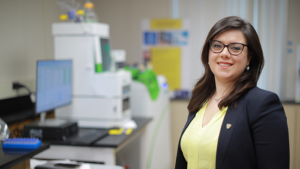The cannabis market is an emerging one in agriculture, and along with it comes a learning curve for how to grow and harvest crops, marketing products, and understanding pesticide applications. So a chemical analyst and expert in micro-extraction at The University of Toledo created a more reliable, robust and efficient way to monitor pesticide exposure and help protect the health and safety of agricultural workers in emerging sectors like the cannabis industry.
Dr. Emanuela Gionfriddo, an assistant professor of analytical chemistry, and Nipunika H. Godage, a Ph.D. candidate, published research in the journal Analytical and Bioanalytical Chemistry outlining their groundbreaking method that is able to detect 79 pesticide residues in human blood plasma at “ultra-trace” levels, or parts per trillion.
“This has the potential to be applied to human exposure studies for the general public such as exposure through food or contaminated water but, most importantly, agricultural workers who have a higher potential for acute exposure to these toxic chemicals, which typically occurs through the skin, with pesticides then passing into the bloodstream and circulating through the body,” Gionfriddo said.
Pesticides are widely used in farming to prevent or reduce produce losses caused by pests and improve the quality of fruits and vegetables, but human exposure during mixing or application can be hazardous to workers’ health.
Though pesticides are regulated by the U.S. Environmental Protection Agency, Gionfriddo said the legalization of cannabis recently in several states has led to “inexperienced” farmers exposing themselves to the harmful chemicals since those workers are less familiar with pesticide safety equipment and procedures as well as proper pesticide storage and handling.
The pesticides selected for her study are the most commonly used pesticides during cannabis cultivation.

Gionfriddo’s new testing method uses what’s called bio solid-phase microextraction with liquid chromatography-tandem mass spectrometry.
“To meet the growing demands of regulatory agencies and routine analysis laboratories, sample throughput and method tunability is critical,” Gionfriddo said. “Using automated samplers, the preparation time per sample is 1.7 minutes.”
And as occupational exposure to pesticides can occur at varying concentration levels, it is important for any method to quantify pesticides at low concentrations. The new testing method demonstrated higher sensitivity, precision and accuracy and a drastic reduction in abnormalities compared to the commonly used approach, known as QuEChERS, which stands for Quick, Easy, Cheap, Effective, Rugged and Safe but can be labor intensive with prolonged workflows.
Last week during National Farmworker Awareness Week, the U.S. EPA said pesticide exposure doesn’t only happen when working in the fields. The federal agency said pesticide take-home exposure can occur when farm workers go home bearing pesticide residues that may cling to their skin, clothing, hats, boots, tools, lunch coolers or other items in their work environment.


